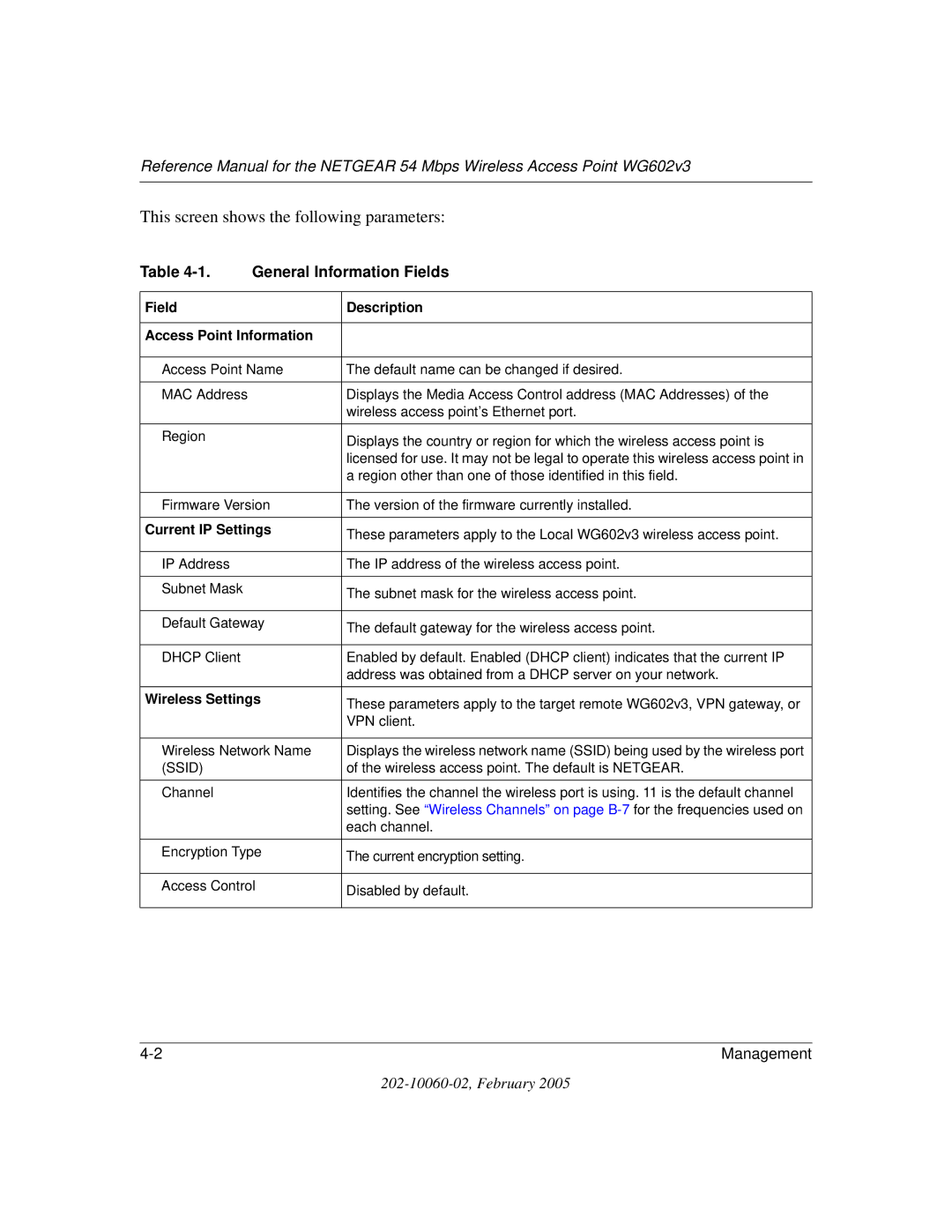202-10060-02, February
Technical Support
Netgear Netgear WG602v3 54 Mbps Wireless
Canadian Department of Communications Compliance Statement
Contents
Chapter Management
Appendix a Specifications
Glossary
Chapter About This Manual
Audience, Scope, Conventions, and Formats
How to Use This Manual
How to Print this Manual
Printing a Page in the Html View
About This Manual
About the Netgear WG602v3 54 Mbps Wireless Access Point
Chapter Introduction
Support for Standards
Key Features
802.11g Standards-based Wireless Networking
Wireless Multimedia WMM Support
Autosensing Ethernet Connections with Auto Uplink
Compatible and Related Netgear Products
System Requirements
What’s In the Box?
WG602v3 Wireless Access Point Front Panel
Hardware Description
Access
Chapter Basic Installation and Configuration
Observing Placement and Range Guidelines
Default Factory Settings
Feature Factory Default Settings
Understanding WG602v3 Wireless Security Options
Installing the Netgear WG602v3 54 Mbps Wireless Access Point
Configure LAN and Wireless Access
Deploy the WG602V3 Access Point
Two Ways to Log In to the WG602v3
How to Log in Using the Default IP Address of the WG602v3
Login result WG602v3 home
How to Log In to the WG602v3 Using Its Default NetBIOS Name
Example WG602v3 NetBIOS name in browser address bar
Using the Basic IP Settings Options
Access Point Name NetBIOS
Understanding the Basic Wireless Settings
IP Address Source
Basic Installation and Configuration
Understanding Wireless Security Options
10 Security Settings menu
Basic Installation and Configuration
If WPA-PSK or WPA2-PSK Authentication is Used
How to Configure WEP Wireless Security
11 WEP Settings
How to Configure WPA-PSK Wireless Security
12 WPA Settings menu
How to Configure WPA2-PSK Wireless Security
13 WPA2 Settings menu
How to Configure WPA-PSK/WPA2-PSK Wireless Security
14 WPA/WPA2 Settings menu
How to Restrict Wireless Access by MAC Address
15 Access Control options
Basic Installation and Configuration
Basic Installation and Configuration
Chapter Management
Viewing General Information
This screen shows the following parameters
Upgrading the Wireless Access Point Software
Viewing a List of Attached Devices
WG602v3 Upgrade Firmware
Rebooting and Resetting Factory Default Options
Restoring the WG602v3 to the Factory Default Settings
Changing the Administrator Password
Set Password
Chapter Advanced Configuration
Understanding Advanced Wireless Settings
Configuring Wireless Distribution System Links
How to Configure Wireless Bridge Links
Wireless Bridging
As a Point-to-Point Bridge
Configure the Operating AP1 on LAN Segment
How to Configure Wireless
Advanced Configuration
Advanced Configuration
No lights are lit on the access point
Chapter Troubleshooting
Troubleshooting
Ethernet LAN light is not lit
Wireless LAN activity light is not lit
Cannot configure the wireless access point from a browser
Using the Reset Button to Restore Factory Default Settings
When I enter a URL or IP address I get a timeout error
202-10060-02, February
Appendix a Specifications
Specifications for the WG602v3
Specifications
Appendix B Wireless Networking Basics
Wireless Networking Overview
Infrastructure Mode
Authentication and WEP Data Encryption
Ad Hoc Mode Peer-to-Peer Workgroup
Network Name Extended Service Set Identification Essid
Authentication
Open System Authentication
Authentication Open System Steps
Authentication Shared Key Steps
Key Size
Wireless Channels
WEP Configuration Options
WPA and WPA2 Wireless Security
How Does WPA Compare to WEP?
What are the Key Features of WPA and WPA2 Security?
How Does WPA Compare to WPA2 Ieee 802.11i?
Wireless Networking Basics
Figure B-3 WPA/WPA2 Overview
Access point replies with an EAP-request identity message
WPA/WPA2 Data Encryption Key Management
Temporal Key Integrity Protocol Tkip
Is WPA/WPA2 Perfect?
Product Support for WPA/WPA2
Changes to Wireless Access Points
Changes to Wireless Client Programs
What is a Router?
Appendix C Network, Routing, Firewall, and Cabling Basics
Basic Router Concepts
IP Addresses and the Internet
Class E Class E addresses are for experimental use
Netmask
Subnet Addressing
Figure C-2 Example of Subnetting a Class B Address
Table C-1. Netmask Notation Translation Table for One Octet
Single IP Address Operation Using NAT
Private IP Addresses
IP Configuration by Dhcp
Following figure illustrates a single IP address operation
Domain Name Server
Routing Protocols
Internet Security and Firewalls
MAC Addresses and ARP
Ethernet Cabling
What is a Firewall?
Denial of Service Attack
Stateful Packet Inspection
Table C-1 UTP Ethernet cable wiring, straight-through
Category 5 Cable Quality
Inside Twisted Pair Cables
Figure C-4illustrates straight-through twisted pair cable
Uplink Switches, Crossover Cables, and MDI/MDIX Switching
Network, Routing, Firewall, and Cabling Basics
Network, Routing, Firewall, and Cabling Basics
Appendix D Preparing Your PCs for Network Access
Preparing Your Computers for TCP/IP Networking
Configuring Windows 98 and Me for TCP/IP Networking
Installing or Verifying Windows Networking Components
Enabling Dhcp to Automatically Configure TCP/IP Settings
Dhcp Configuration of TCP/IP in Windows 98 and Me
Choose Settings, and then Control Panel
Selecting the Windows Internet Access Method
Verifying TCP/IP Properties for Windows 98 or Me
Configuring Windows 2000 or XP for TCP/IP Networking
Dhcp Configuration of TCP/IP in Windows XP
TCP/IP details are presented on Support tab
Dhcp Configuration of TCP/IP in Windows
Right click Local Area Connection and select Properties
Obtain an IP address automatically is selected
Verifying TCP/IP Properties for Windows XP or
Preparing Your PCs for Network Access
Glossary
802.11e Standard
Access Point AP
Bridge
CSMA-CD Carrier Sense Multiple Action/Collision Detection
Essid more commonly referred to as Ssid Short Set Identifier
Ieee Institute of Electrical and Electronics Engineers
MAC Media Access Control
PHY
Range
Site survey
TCP/IP
War Driving
Wi-Fi Protected Access and Ieee 802.11i Comparison
Wi-Fi Protected Access in Mixed Mode Deployment
Glossary
